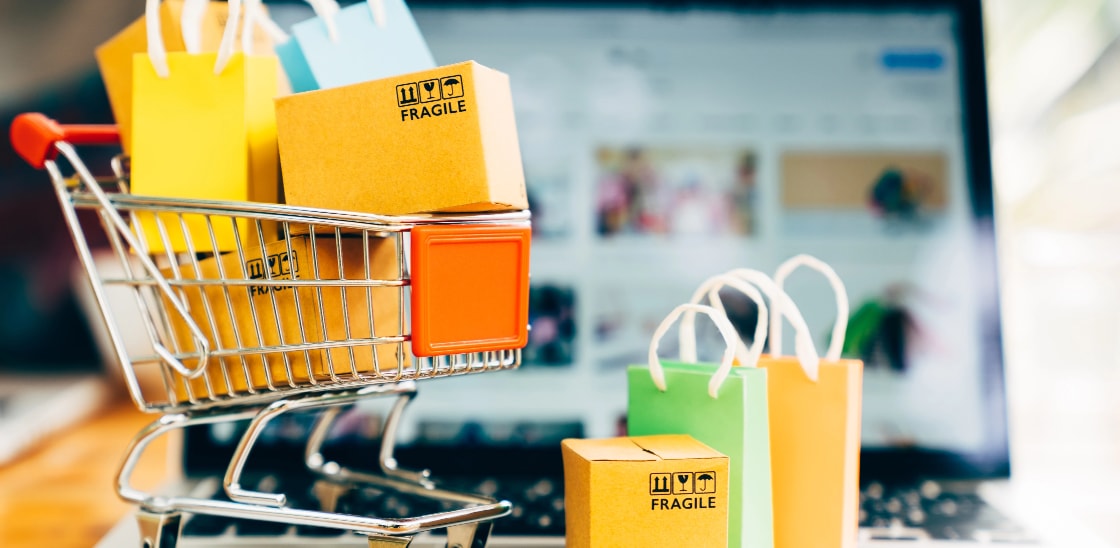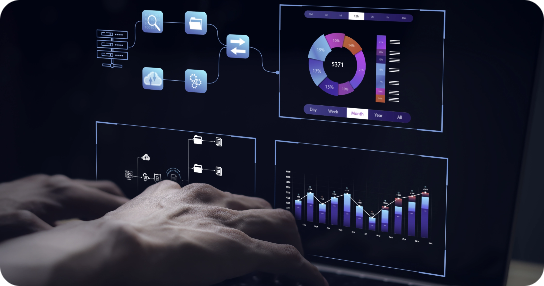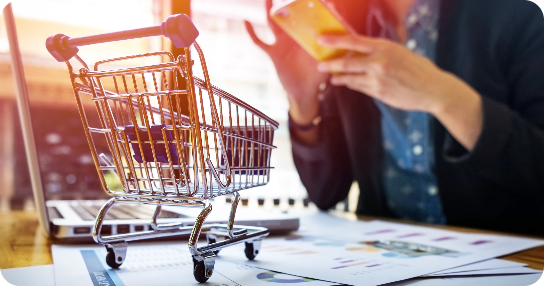Unlocking eCommerce growth for CPG with data and analytics
Reading Time: 8 minutes

CPG Ecommerce opportunities in the new normal
The COVID-19 pandemic has compelled businesses to shift to virtual marketplaces and CPG has been no different. Consumers are increasingly preferring online portals instead of brick-and-mortar stores and the time’s ripe for CPG companies to extend their digital reach. Some reports suggest that nearly 60% of consumers feared getting infected from visiting a physical store. This led to more than 50% ordering products online that they would otherwise normally purchase directly from the stores. As per the latest reports, the average spend per grocery order shot up to an all-time high of US$95 per order in August 2020, with the intent of repeat purchase monthly reaching a peak at 75% signifying that online shopping is all set to become one of the reigning CPG trends going forward.

Prior to the coronavirus pandemic, e-commerce business accounted for approximately 4% of all grocery sales, a tiny portion of the overall volume. But during the pandemic share of grocery spending going online has increased to as high as 20% according to Sigmoid analysis. The figure is expected to settle at about 10-12% by 2022. A boost in digital sales of essential goods and personal care products, which were purchased more frequently online during the pandemic, has driven CPG spend growth on e-commerce platforms. Consequently, digital ad spending in the US consumer packaged goods (CPG) industry will increase 5.2% to $19.40 billion in 2020. With marketers relying on data to guide their digital advertising spends, ML-driven Multi Touch Attribution provides them with customer journey insights to optimize campaigns.
Boosting CPG data insights with e-commerce analytics
With the surge in online grocery shopping, copious amounts of user data is getting generated presenting online CPG businesses with unique opportunities. The utilization of e-commerce analytics will glean significant benefits and surely be a game-changer for CPG companies in a highly competitive market. In fact, more than half (52%) of the CPG respondents in a recent survey reported resources to react quicker and analyze faster. Another 7% of the responders predicted their analytics spending to reach 25% of their total IT expenses by 2023. Organizations are clearly inclined to bolster their data analytics initiatives. However, they also need to plan and execute their data strategy for CPG carefully.
Boosting CPG data insights with e-commerce analytics
With the surge in online grocery shopping, copious amounts of user data is getting generated presenting online CPG businesses with unique opportunities. The utilization of e-commerce analytics will glean significant benefits and surely be a game-changer for CPG companies in a highly competitive market. In fact, more than half (52%) of the CPG respondents in a recent survey reported resources to react quicker and analyze faster. Another 7% of the responders predicted their analytics spending to reach 25% of their total IT expenses by 2023. Organizations are clearly inclined to bolster their data analytics initiatives. However, they also need to plan and execute their data strategy for CPG carefully.
CPG companies must invest more in analytics to align their strategies and business models with evolving consumer trends and requirements. The first step toward unearthing actionable data insights is to outline the data type to be considered. Usually, there’s no single set of data that is used across all business types. Data requirements vary along with the specific requirements of the industry, the market, or even the individual business entity. However, datasets can be broadly categorized into product-based data and consumer behavior data. Product-based data includes tracking and logging product-specific trends and statistics. Some product specific datasets are:
- Individual product sales trends
- Sales analysis of products within a category
- Distribution
- Price analytics
Customer behavior data points on the other hand, would include tracking and logging purchase behavior, preferences, and trends of online shoppers. Customer specific datasets are:
- Frequency of making purchases
- Cart abandonment to transaction completion analysis
- Brand/ Store loyalty
- Consumer demographics
Once the required data has been made available, the next step is to glean insights out of the available data. Specific analysis needs to be done keeping the end goal in mind. The data obtained can be utilized in various ways, such as:
- Personalized marketing: This involves understanding consumer behavior to determine preferences and generate recommendations. Learn how Personalized recommendations driven by Advanced analytics improved customer experience and product sales for a popular cosmetic brand. As a future forward representation, a leading online retailer has patented a new feature that enables smart speakers to detect when a user is under the weather and generates recommendations accordingly including specific dietary choices from their pantry.
- Order fulfilment: The surge in online CPG retails is redefining traditional order fulfilment process. With online retail, CPG players are now able to cater to a wider demographic as well as a larger geographic footprint while short term trends such as bulk buying behavior is also compelling them to mold their business approach. In this new business paradigm, they need to build on capabilities to capture data from Omni-channel sources and create data lakes to ingest and analyze data from disparate sources.
- Product launches: Today CPG companies mostly depend upon retailers for consumer data generated from POS transactions and sales performance figures. In a new normal, the proliferation of online retail will generate significantly larger and substantially more diverse data streams which will provide the CPG companies with newer opportunities to leverage user data. This will help them redefine personalized recommendations with newer perspectives and offerings.
- Category specific decision-making: CPG analytics output can objectively highlight strengths, weaknesses, inefficiencies, and opportunities rife within a particular product category giving granular visibility into each product type. Businesses that have successfully adopted data analytics enabled decision-making have seen up to 22% increase in demand for specific products.
What CPG firms require to build e-commerce strategy
Data culture and automation: Culture of data as an asset, predictive analytics, and AI fully embedded in day-to-day operations and embraced by company leadership to swiftly address shifts in e-commerce demand, supply chain, and consumer preferences. Reduction in manual labor by automating processes across functionalities for demand forecasting.
Digital infrastructure: Connected data platforms, IT, and infrastructure that enable full visibility of the customer’s path to purchase and e-commerce dashboards that provide real-time insights into changes in demand. Prioritize customer-centricity across critical touchpoints to improve conversion rates and drive revenue growth.
Partnerships and ecosystem: Forge strategic alliances to establish ecosystems that differentiate customer services. CPGs partnering with 3 PLs and digital natives is a vital element in exploration of new revenue streams and operating models. Acquire or partner with digital specialists to contain costs by expediting and optimizing processes.
The need to bolster data engineering capabilities
In the current scheme of things, it’s a business imperative for CPG players to leverage data analytics to enable quicker yet informed decision making and achieve consistent business gains. But how do CPG organizations gain the most out of the consumer and product data? Building data engineering proficiency and the ability to collect and utilize comprehensive data pertaining to customer journey will become highly relevant for CPGs rather than only relying on external inputs. Data engineering is fundamental to achieving quantifiable gains from analytics. It can help CPG companies create interfaces and mechanisms that dictate the flow and access of data.
Building out the overall strategy for data engineering requires scoping out data needed to align with business objective and availability.
When it comes to building a solid data foundation for ecommerce, CPG companies should consider the following:
- Building data pipelines: It is important to build a scalable data pipeline that can be queried at high speed and hosted in a cloud environment. This encompasses collecting data from different sources, storing the data including in data lakes and in-memory processing.
- Data warehousing: Data pipelines collect data from multiple sources and store them in data warehouse in a structured format via ETL. This acts as a single source of truth simplifying the company’s analysis & reporting processes.

- Data governance: Establishing processes for data availability, integrity, visibility to users, and security.
- ML models in production: Integrating production ready machine learning models into the workflows can be the key to optimizing the available data and gaining significant business benefits.
- Embrace AI/ML: Leverage predictive analytics and AI to improve financial metrics and the overall customer experience. Develop predictive analytics and AI use cases to transform processes, optimize operations, and enhance customer experiences.
- Customer data platform: Enables brands to collect, unify, enrich and activate their customer data effectively. To manage and enhance the 1st party data that is required to better know and engage with consumers to drive increased margins and revenue.
Uncovering insights from granular user data and other data types such as transactional data, operations data, etc. will allow CPG companies to develop a more personalized approach to reaching and engaging with shoppers. More importantly, companies need to create an effective data strategy that is aligned with the business goals in order to derive value from the data while driving ROI.
New age e-commerce players have already challenged the status quo and successfully exhibited the perks of effectively leveraging data. Even though CPG companies have been investing in data analytics, they need to revamp their approaches to fit the current paradigm. CPG companies with data-driven, customer-centric strategies will gain more traction due to the demand for more personalized, convenient, and safe shopping experiences.

Advanced analytics can drive incremental revenue growth by up to 10% by helping companies launch new lines or modify products based on customer preferences. It can also improve profitability by 1% – 2% by helping companies optimize their manufacturing and supply chain processes.
Conclusion
Fundamental shifts in shopping and consumer attitudes have changed the grocery landscape forever. The CPG sector which is heavily dependent on what happens in grocery retail will have to adapt to the new models. E-commerce sales are accelerating as CPG firms focus on business sustainability and customer engagement. For a USD 635 billion-sized CPG business in 2019 with a 2% annual growth, if 10% share of total revenue is expected to come from ecommerce, that means a significant business opportunity for the future.
While CPGs have been conservative in leveraging emerging technologies due to the need for upfront investment, the pandemic is compelling them to rapidly adopt and integrate digital technologies. The ability to harness data around the rapidly shifting environment has become an important differentiator. CPG companies that move into action quickly to enhance their e-commerce capabilities and leverage data analytics to address consumer needs will emerge winners.
About the author
Jayant is Director of Marketing and Pre-sales at Sigmoid and is passionate about applying data & analytics to solve business problems. He has helped CPG and Retail companies globally to leverage IT for business transformation.
Featured blogs
Subscribe to get latest insights
Talk to our experts
Get the best ROI with Sigmoid’s services in data engineering and AI
Featured blogs
Talk to our experts
Get the best ROI with Sigmoid’s services in data engineering and AI






